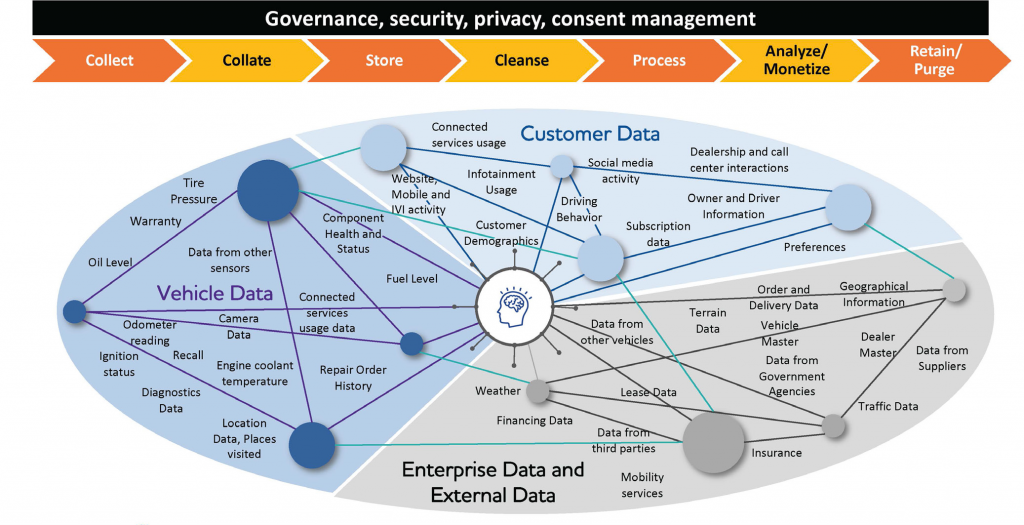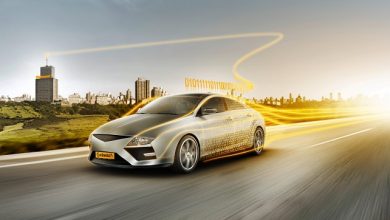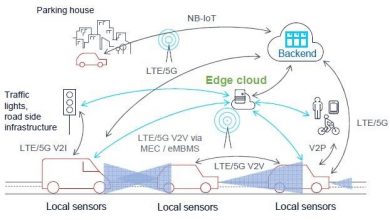Data-Led Personalization in the Era of Connected Mobility

You watch your favorite movie on Netflix and soon the streaming platform starts recommending movies that you may like. Netflix can understand your movie preferences and recommend movies best suited to your preferences. Similarly, Amazon shows you products that are relevant to you and provides recommendations based on your shopping history and other similar shopping behavior. Spotify does the same with the ‘discover weekly’ playlist that recommends songs that you have not listened to before but may like.
Have you ever wondered, what it would be like if your car could do the same? For instance, what if your car lets you to do a voice search for a restaurant during a drive, or automatically asks if you want to dial into a meeting when you are stuck in traffic? Or provide you with a contextual recommendation for an accessory based on your lifestyle or driving habits?
With the increasing adoption of connected vehicle technologies, vehicle owners are expecting personalized and differentiated connected vehicle services. This expectation has started influencing purchase decisions of buyers.
A car has expanded beyond the horizon of a mere mode of transportation and transformed into a digital experience center, which is deeply integrated with the lifestyle of the customer. It is an extension to the connected home and office, and acts as an important digital touchpoint in the day-to-day journeys.
“Any customer can have a car painted any colour that he wants, so long as it is black” – Henry Ford had said1 about the first mass-produced vehicle2, Model T in 1909. Since then, the automotive industry has evolved to provide higher levels of personalization to the customers, by giving them the choice of variants and colors, and letting them choose their favorite accessories.
The industry is now heading towards an era of hyper-personalization, which permeates through all stages of the ownership lifecycle. Connected vehicle services and the insights gathered from the connected ecosystem play a key role in enabling this.
Global vehicle manufacturers have been making huge investments in connected vehicle technologies. However, many have struggled to differentiate their connected vehicle services and generate interest among customers3.
One of the reasons for this could be that customers get similar services via smartphone applications, often free of cost, and they are not convinced of the additional value in the connected services offered by their vehicle manufacturer3.
While Automotive OEMs are providing a multitude of connected vehicle capabilities, they are yet to get a pulse on the needs of customers for providing highly personalized and exciting journeys.
So, what is the secret sauce to enable these hyper-personalized journeys?
We believe that a software-driven vehicle architecture, digitization of customer touchpoints and effective leveraging of data from the connected vehicle ecosystem are key enablers for driving hyper-personalization. Let’s take a closer look at how this can be achieved.
Personalization across the vehicle ownership journey
In order to drive customer loyalty, it is important to personalize the customer experience across all stages of the vehicle ownership journey. Some examples of this include targeted marketing campaigns and contextual recommendations during the vehicle purchase process, personalizing the in-vehicle experience, contextual recommendations for restaurant or fuel stations, proactive service recommendations and customized end of lease offers.
Some car manufacturers provide a ‘driver profile’ feature to personalize the in-vehicle settings. Tesla’s driver profile feature4 allows drivers to store their favorite settings for steering wheel and seat positions, rear view mirror, driving style, lights and locks, formats and units, and maps, to match the driver’s preference. With one push of a button, the driver can enable the best-suited driving profile, without having to manually select each setting.
Another interesting example is that of BMW UK, which displays personalized warranty messages5 in electronic signboards at stop signs. The messages are personalized by showing the image of the model of BMW driven by the user, determined using image recognition techniques. Such personalized advertisements catch the attention of the drivers.
Porsche’s car configurator6 is another good example of personalization in the vehicle purchase process. The configurator provides personalized recommendations on options best-suited to the each customer and makes the vehicle configuration process seamless. This recommendation engine is built on 270 machine-learning models that were trained for specific markets, and works with about 90% accuracy.
As more customer touchpoints are digitized and more vehicle features are enabled through software, we can be sure of a huge leap in the number of personalized offerings across the automotive value chain.
Software-Driven Architecture as an Enabler for Personalization
Automotive product development is being redefined through the software-defined architecture. This is helping drive higher levels of personalization. Automotive OEMs are working towards improving their software competency and transforming towards a software-driven culture. An example of this is Cariad7 – an automotive software company that bundles together Volkswagen Group’s software competencies and further expands them, building upon a heritage of bringing automotive innovation to everyone.
Vehicle features are now being offered on demand, supported by software updates. Tesla has been a leader in adopting such a software-driven approach. It has enabled feature upgrades and fixes, which can be done remotely via software updates. Now, many automotive OEMs are looking to offer vehicle features on demand. For instance, BMW is offering heated seats8 on a subscription basis.
Developing the infrastructure to deliver vehicle features via software updates provides a great opportunity to respond quickly to the customer needs and offer them capabilities suited to their specific journeys. For example, a vehicle owner may want to opt for highway driving assistance capabilities for a long drive planned during a long weekend.
Leveraging the Data from the Connected Vehicle Ecosystem
There is tremendous value in the data that is now available through a connected vehicle. As Automotive companies improve their vehicle connectivity and introduce more digital services, activities in the ecosystem will produce a wealth of information. This information can be leveraged for providing a personalized experience to the customers, and improving the products and services. This helps OEMs to shift from the mindset of a “one-time sale of a vehicle” to owning a customer for life and owning the vehicle lifecycle.
The data from the connected ecosystem could provide deep insights to enable a personalized experience through better prediction of customer needs. This experience needs to be provided across all stages of the vehicle ownership journey – including the vehicle purchase process, driving experience, service experience and transition to the next vehicle.
For example, based on analytical models, we can predict when the customer is likely to purchase the next vehicle and recommend the best-suited vehicle based on the customer’s usage journeys. Similarly, a deep understanding of the customer’s personal traits and preferences helps in recommending the right subscription plans, accessories and offers that excite the customer.
Vehicle as a Data Model
To leverage the full potential of data for personalization, product quality improvements and monetization, it is very important to have a robust infrastructure for data lifecycle management covering various aspects such as data collection, storage, cleansing, processing and retention. A strong framework for data governance, security, privacy and consent management is essential to prevent unauthorized access to data and comply with legislative requirements.
The data infrastructure needs to include and seamlessly integrate vehicle data, customer data as well as data from enterprise systems and external sources. By connecting these data elements, we will be able to realize a lot more value than what was possible through a siloed data analytics approach.
We envision the concept of ‘Vehicle as a data model’ that connects typically siloed user, vehicle, and enterprise data, enabling new insights to enhance customer experience and optimize value. This provides a holistic view of the customer and enables smarter decision-making. This data model could provide a 360-degree view of the customer and lays the foundation for providing a personalized experience.
When connected with other data elements like their demographics, vehicle usage history, service center preference, insights around the customer’s preferences and interests, the customers’ lifestyle attitudes could be gleaned and used to tailor targeted campaigns and provide differentiated experiences.

For example, the customers’ household income, spend on accessories, repair orders, and the lifestyle information gathered from analytical insights could indicate whether the customer is a good candidate for upselling/cross-selling additional services.
Similarly the vehicle’s diagnostics data could be linked with the navigation data to gain insights on the customers’ aftersales service behavior for specific types of services. There are numerous such possibilities that open up when we cross-leverage the connected vehicle data with the data from the other enterprise systems.
However, while implementing these initiatives, proper care must be taken to ensure that only consented data is collected, stored and distributed. There are data protection regulations such as GDPR in Europe, CCPA and CPRA in the US, PDP in India and other country specific regulations, which must be strictly adhered to. These regulations mandate that drivers need to be provided information on what data is being collected, the purpose of collection and the use of the data. Vehicle manufacturers will also have to maintain a system to allow for customers to see what data is being collected on them overall, and also have the ability to exercise their data subject rights, such as deletion (right to forget) of data.
TCS Solutions
TCS has enabled global automotive OEMs to develop vehicle onboard and offboard capabilities. TCS AutoscapeTM suite of solutions brings together these experiences and cross-industry expertise relevant to the connected vehicle ecosystem to offer an end-to-end connected data management and customer experience solution. This includes Connected Vehicle Experience – a digital experience platform for enabling personalized and differentiated customer vehicle experience and Connected Insights – an analytics solution that enables Automotive OEM’s and other ecosystem partners to derive actionable insights from the data. The connected insights solution provides deep insights into customer personas and helps automotive companies realize the vision of hyper-personalization. It provides insights into customers’ journey patterns, persona traits, driving behavior, and social media behavior, preferred points of interest, aftersales service behavior etc. and helps Automotive OEMs to personalize recommendations, increase vehicle and accessory sales and improve service retention rate and revenue.
Our Data monetization toolkit, comprising of the subscription platform, consent management solution and Data Marketplace platform, enables OEM’s and ecosystem players to democratize and monetize the data, enables newer business models through subscriptions and address all aspects of data privacy and consent management.
Future of Personalization
We believe that in the near future, vehicle will evolve to become a Digital experience platform by which insurers, retailers and other ecosystem partners will be able to create new and unique personalized offerings for their customers. Software will play a very important role in the vehicle architecture and automotive companies will look to strengthen their software capabilities, in order to remain competitive in the market. There will be an increase in vehicle features offered on demand via software updates. This will drive the evolution of ecosystem play where OEM’s and ecosystem players need to collaborate and work together to innovate and provide a seamless customer experience. Customer touchpoints across the ownership lifecycle will be digitized significantly and the interactions with dealer and the OEM will become smarter and more efficient by leveraging artificial intelligence and other digital tools.
As the data estate grows exponentially, there will be significant investments in Analytics and Insights capabilities across the ecosystem. This also provides ample monetization opportunities for all the stakeholders. We are looking at a future in which hyper-personalization will become a standard expectation from the mobility customer. Leading companies can gain a competitive advantage through hyper-personalization by leveraging the power of data and analytics.
Tata Consultancy Services (TCS) a leading global IT services, consulting and business solutions organization, which has been named a Leader in the Everest Group PEAK Matrix® for Autonomous, Connected, Electric and Shared (ACES) Mobility Automotive Engineering Services, has been working with automotive clients in this transformation journey, to help them realize the vision of hyper-personalization.
References
1. https://en.wikiquote.org/wiki/Henry_Ford
2. https://en.wikipedia.org/wiki/Ford_Model_T
4. https://www.tesla.com/sites/default/files/blog_attachments/software_update_1.13.16_0.pdf
5. https://www.cnet.com/roadshow/news/bmw-uk-public-warranty-personalized-marketing/
Author Profile:
Vijay Suryanarayanan
Industry Leader, Connected Vehicles
Tata Consultancy Services
Vijay Suryanarayanan is an Industry Leader, who heads the connected vehicle solution portfolio in the C.A.S.E Industry segment in TCS. He has about 18 years of Consulting, Product Management and leadership experience, with a focus on the Automotive Industry. His focus area is to drive growth and transformation in the connected vehicle area, through transformative industry solutions and thought leadership.
Laksh Parthasarathy
Global Business Head, C.A.S.E Industry Segment
Tata Consultancy Services
Laksh Parthasarathy is the Global Business Head for the C.A.S.E Industry segment in TCS. With over 25 years of experience as a thought leader in the automotive industry, he primarily focuses on developing business models and solutions to address industry challenges and enable customers accelerate their C.A.S.E journey.
Published in Telematics Wire



